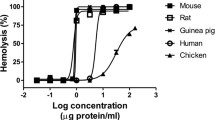Abstract
The stability of homeostasis is important to keep a balance between coagulation and fibrinolysis. A disorder of homeostasis leads to different physiological changes and causes different diseases such as cardiopathies and malignant tumors. Cardiopathies is characterized by a hypercoagulation. In the malignant tumors, besides the hypercoagulation due to plasminogen activators (PA) formed inside the tumor, a disorder of homeostasis leads also to acceleration of the fibrinolysis. The variety of internal and external factors in both cases determine the deviation of time for the clots formation, as well as the lyses of blood and fibrin clots. In this study the venous blood as well as the blood and the fibrin clots, derived from healthy dogs, the dogs with cardiopathies and with malignant tumors, were examined for the time of coagulation and fibrinolysis by adding different substances. In these experiments we used a glycolipoprotein extract from earthworm tissue homogenate (G-90) and the proteolytic enzymes PI and PII, isolated from G-90. The efficacy of the tested substances was comparable with the clinically administered anticoagulants. The most significant differences in clotting time among the three tested groups of dogs were obtained by application of the original G-90. The results suggest a possibility that G-90, along with the fibrinolytic enzymes and other biologically active factors, also contains a factor that decelerates the formation of clot in a specific medium, such as the blood from the dogs with malignant tumors. (Pathology Oncology Research Vol 7, No 3,197-202,2001)
Similar content being viewed by others
References
Brommer EJP, Emeis JJ, Verheijen JH, et al: Progress in Clinical Fibrinolysis. In: 7 Recent Advances in Blood Coagulation. (Eds. Poller L and Ludlam CA), Churchill Livingstone, 1997, pp 161–182.
Gandolfo GM, Conti L, Vercillo M: Fibrinolysis Components as Prognostic Markers in Breast Cancer and Colorectal Carcinoma. Anticancer Res 16:2155–2160, 1992.
Glassman A: Hemostatic abnormalities associated with cancer and its therapy. Ann Clini Labo Sci 27:391–395, 1997.
Dickneite G, Nicolay U, Friesen HJ, et al: Development of an anti-bleeding agent for recombinant hirudin induced skin bleeding in the pig. Thrombo Haemost 80:192–198, 1998.
Du Z, Li X, Qian J, et al: Effect of earthworm fibrinolytic enzyme given orally on the activity of plasmin and on platelet aggregation in beagles dogs. Acta Acade Medi Shang 25:229–231, 1998.
Hr enjak T, Hr enjak M, Ka uba V, et al: A new source of biologically active compounds-earthworm tissue (Eisenia foetida, Lumbricus rubelus). Comp Biochem Physiol 102A:441–447, 1992.
Hr enjak M, Kobrehel D, Levanat S: Mitogenicity of the earthworm’s (Eisenia foetida) insulin-like proteins. Comp Biochem Physiol 104B:723–729,1993.
Hr enjak T, Popoviæ M, Bo iæ T, et al: Fibrinolytic and anticoagulative activities from the earthworm Eisenia foetida. Comp Biochem Physiol 119B:825–832, 1998.
Hr enjak T, Popoviæ M, Ti ka-Rudman LJ: Fibrinolytic activity of earthworms extract (G-90) on lysis of fibrin clots originated from the venous blood of patients with malignant tumors. Pat Oncol Res 3:206–211, 1998.
Oberhoff C, Szymeczek J, Hoffmann O, et al: Adjuvant antiestrogen treatment with tamoxifen in postmenopausal women with breast cancer: A longitudinal study of blood coagulation and fibrinolysis. Breast Canc Res Treat 50:73–81, 1998.
Okita Y, Takamoto S, Ando M, et al: Coagulation and fibrinolysis system in aortic surgery under deep hypothermie ciculatory arrest with aprotinin. The importance of adequate heparinization. Circulation 96:376–381, 1997.
Popoviæ M, Grdi a M, Vukoviæ S, et al: Adhesins of immunoglobulin-like superfamily from earthworm Eisenia foetida. Gen Pharmacol 30: 795–800, 1997.
Sagripanti A, Capri A, Zacharski LR. The Pathophysiology of the haemostatic system in cancer patients: Insights gained from studies using plasmatic markers of haemostatic system activation. In: Cancer and Blood Coagulation: basic and clinical aspect. (Eds. Sagripanti A, Carpi A and Zacharski LR), Ets Editrice, 1990, pp 69–92.
Van Zutphen LFM, Baumans V, Beynen AC: Principles of Laboratory animal science. (Eds. Van Zutphen LFM, Baumans V and Beynen A C), Elsevier Science Publishers, 199
Author information
Authors and Affiliations
Corresponding author
Additional information
Supported by the Ministry of Science of Croatia
Rights and permissions
About this article
Cite this article
Popoviæ, M., Enjak, T.M.H., Babiæ, T. et al. Effect of Earthworm (G-90) Extract on Formation and Lysis of Clots Originated from Venous Blood of Dogs with Cardiopathies and with Malignant Tumors. Pathol. Oncol. Res. 7, 197–202 (2001). https://doi.org/10.1007/BF03032349
Received:
Revised:
Accepted:
Issue Date:
DOI: https://doi.org/10.1007/BF03032349




